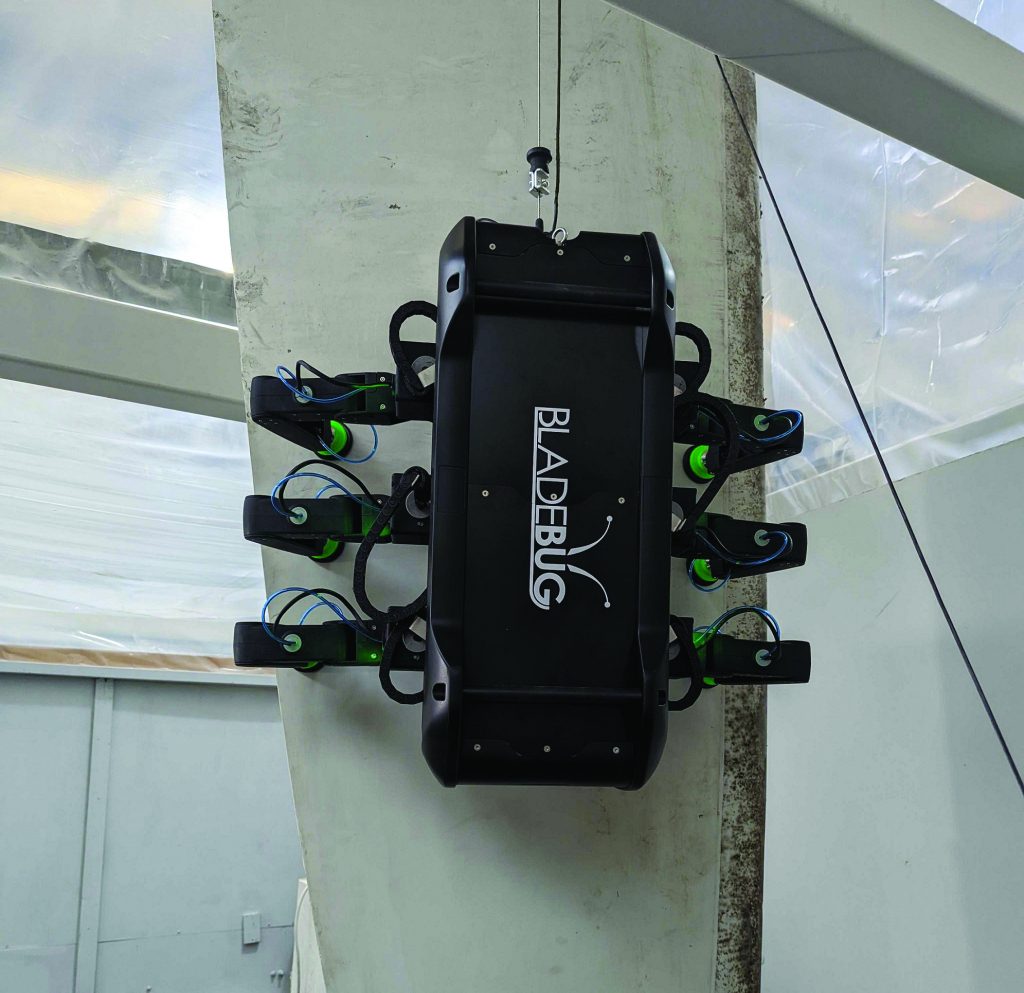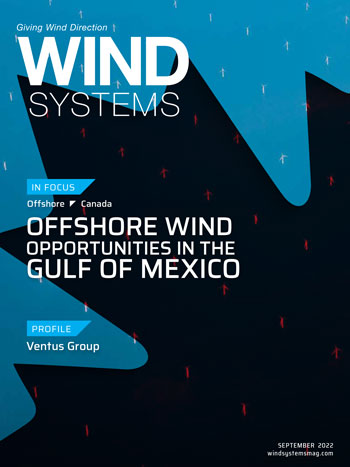BladeBUG is developing advanced robots to assist technicians in the inspection and repair of turbine blades, without the need for rope access. Wind Systems recently talked with Chris Cieslak, director and founder of BladeBUG, where he discussed the innovative technology.
What was your inspiration behind BladeBUG?
I come from a wind turbine/blade designer background. Whilst working on blade design and trying to improve efficiency, I realized that once the equipment had left the factory, blades were often left to their own devices. At most, an annual inspection may take place and, when sufficient damage on multiple blades in a wind farm were visible, a campaign to repair them could be justified.
I noticed an opportunity to place that same level of care and attention into blades once they left the factory. I believed that there was a better way to ensure all blades were spinning efficiently and damage free, for as long as possible. By keeping on top of any minor defects, large and expensive problems could be prevented. The inspiration for BladeBUG was, therefore, to try to ensure blades are kept in the best possible condition for their entire design life.
BladeBUG utilizes the knowledge I garnered in blade design and manufacturing and combines this with a robotics system, taking a more proactive approach in blade management. At the time of founding BladeBUG, we were fortunate that robotic technology had also significantly progressed.
What is the BladeBUG robot designed to do?
The BladeBUG robot is designed to be agnostic. We have designed the robot to be a platform whereby we can mount different tool payloads, depending upon what is required. We can have inspection payloads, which work in harmony with drone inspections.
People often ask why BladeBUG does not use a drone. Whilst drones are excellent at the overall imaging of the blades, we believe that the follow-on inspections are problematic. The BladeBUG robot is able to go onto the blade, where defects have been pre-identified, and perform a much more thorough inspection.
This can be as simple as a visual inspection because the robot is able to get so close to the damage that we can obtain a clear and stable image. We can also go beyond this, too, by mounting ultrasonic, non-destructive testing equipment to the robot, allowing us to conduct subsurface scans. Drones are a non-contact visual so they can provide the next level of information. As a result of the BladeBUG robot performing a subsurface defect investigation, we can understand specific areas, such as: If there is a crack, does that crack propagate much deeper beneath the surface? Do you have a de-lamination? Basically, it is about gathering more data in order to make informed decisions about how the asset is treated.
For example, if there is an image from a drone inspection that shows a crack, BladeBUG can go there and determine the size and scale. This information can be passed on to a blade-repair company, and they will know exactly what to expect. This minimizes the time a rope access technician is required to undertake dangerous repairs. Even better, if it is a minor defect, the robot can treat it without the need for on-blade human intervention.
BladeBUG is about rectifying problems early. If it is too big a problem, then it’s about providing better quality data to ensure more informed decisions.

Tell us more about the repair side of the design.
At BladeBUG, we are looking at some of the crucial areas on the blade. Leading edge erosion is a key element we are currently focusing on. Our robot has the ability to straddle the leading edge and perform sanding and cleaning operations, as well as applying coatings.
This can work twofold: We can work alongside technicians, assisting them with some of the more monotonous tasks, which allows them to focus upon more prevalent repair and maintenance tasks. However, that is not the end of the story, as BladeBUG is looking to offer the turnkey ourselves in the future.
Our inspection equipment is interesting as it is essentially “off-the-shelf” tools that the industry currently uses. At BladeBUG, we essentially mount them within a robot, turning them into remotely operable systems. With the repair element, it involves more bespoke tools that we are developing in-house to solve specific issues.
We are also aware that blade life is approximately 20 to 25-plus years, and technology is always changing. We see the BladeBUG as being really useful for applying add-ons to blades — aerodynamic features to improve the efficiencies with the overall objective of making wind turbines operate more productively. We see it as inspection repair, but also with upgrades. It’s this multi-functioning tool that provides a suite of capabilities to the owners, operators, OEMs and independent service providers.
Does BladeBUG help in keeping technicians safe?
There is an inherent risk when working a hundred meters from the ground, and when you take the inspection offshore, a few hundred miles off the coast, a minor incident can become very serious, very quickly. Wind-turbine technicians require a lot of training. There is so much equipment that requires to be assessed and reviewed with a huge number of processes.
With the BladeBUG robot, we can take away human risk in some of these tasks, such as checking the light and protection system on the blade. It is a matter of putting a probe onto a receptor and measuring the conductivity. It is not a complex task but it currently requires someone to complete it. Our belief is that if the robot can do a task, it reduces the potential of having something go wrong.
There are huge health and safety benefits to that. In addition, when we go to the aerial version, we remove one of the biggest risks, which is transferring people from vessels to the assets. You can compound that even more when you start the introduction of floating offshore turbines, where everything is moving at different rates.
You recently unveiled a new-look concept robot. What makes this version unique?
This is an outcome of a collaboration between BladeBUG and an industrial design company called EGGS Design based in Denmark and Norway. It’s the first time BladeBUG has worked with external designers and engineers. We have spent a lot more time considering how people are going to be using the BladeBUG, which has influenced the new design immensely. Previously, we were focused very much on the R&D and the functionality of the robot. It was great to work with a company that took the concept and the functionality to the next level by interviewing end users and understanding the whole user journey.
Even though its functionality is the same, we have improved both the visual appearance of the BladeBUG and its usability. This has enhanced its operation massively. The BladeBUG now has integrated handles and ingress protection from the environment, such as water and dust.
It’s much more suited to what we have designed it to do, which is operating on a wind turbine and performing multiple tasks. It’s a great combination of taking our knowledge as a robotics company and combining that with the design and knowhow of those who are attuned at turning prototypes into much more productized versions.
We are now at a stage where the concept robot is what people can see as a finalized product. The first impression of our latest robot is a sleeker concept, and that has made a big difference to how people view our product. People like to see a more simplistic, cleaner version. You’re not seeing the wires; you’re not seeing the cabling. They are all still there, but they are just protected now. This makes the robot more robust and reliable because there’s less chance of those wires and cables getting snagged, caught, or coming loose.
The newer BladeBUG was made possible by a grant from the Robots for Inspection Network. How did this award come about?
Through our work with EGGS Design. One of their designers heard about us on a BBC Radio 4 series called, “39 Ways to Save The Planet.” BladeBUG was featured on an episode, and the designer heard it. She was very intrigued about what we were doing and felt that she and the team could help us. They approached us with this opportunity, and we thought about it for about five minutes and said, “Yes, this sounds great.” To have the opportunity to have a really experienced and aligned company to work with us is such a fantastic opportunity. We applied for a grant together, and, thankfully, we were awarded it.
Has there been industry response from your concept; are owner-operators interested in what BladeBUG can do for them?
BladeBUG has been speaking to companies for a few years now. We’re constantly keeping multiple organizations informed and aligned about what we are doing. This new concept has really helped with those conversations because conceptually, everyone loves the idea of what we do, but there was always a slight apprehension in terms of what the robot looked like as a prototype.
Now, when you show them our updated version with the new shell, and they can see it operate, a lot of the concerns have been alleviated, and they, too, are excited about our next conception.
What is the Future for BladeBUG?
We are working on an early adopters pilot program where we have completed one-to-one sessions with end users. We’ve performed end-to-end tasks in front of OEMs, owners, operators, and independent service providers. Recently, we have been in France on a client’s turbine. Next year is when we hope to start working on more commercial projects.
At the moment, we currently take the robot to the end user. However, the overall objective is for us to remain a robotics company and provide the BladeBUG robot as a tool to the industry.
We will provide training for people to use the robot, and then they will be able to go away, have a complete system, and perform the tasks themselves. For the next year, we need to ensure we develop the whole user experience and the user interface to make sure that it’s at the right level, so we can hand it over to customers in 2024.
As a relatively new tech company, we’re always looking for investors, and that’s going to really help accelerate BladeBUG’s growth. This will also allow us to grow our service side of the team. We also hope to get some non-tech related people in to the business to help grow our commercial element, too. This will no doubt come with a lot of trials.
So, if people are interested in our tool, please reach out to us, we will happily give you a demo.
More info bladebug.co.uk































